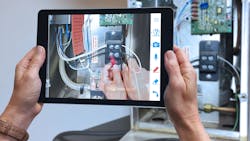Remote Assistance: How Augmented Reality is Helping Organizations During the Pandemic
The current market environment has required new thinking from organizations that need business to continue despite the difficult circumstances. Now, more than ever, remote assistance and augmented reality are key to business continuity and will foster business growth in the future.
Case in point: Munters, a provider of industrial dehumidifier solutions, took note of the impact the coronavirus was having on its business and quickly realized the necessity of implementing remote assistance in its operations—in manufacturing, field service and customer support alike. Within two weeks, 200 staffers spanning 22 countries were equipped with remote assistance.
In recent years, digital transformation has been top of mind for industrial organizations that are looking to get ahead in Industry 4.0. Companies have turned to technology to increase productivity, create a connected workforce and embark upon servitization journeys with aftermarket service contracts—and are realizing the benefits. In the current market environment, organizations that have already integrated technology into their operations are well-placed to practice business continuity during the pandemic.
Having already embraced digital technology, Munters had the tools and platforms in place to continue service operations remotely. But recognizing the impact the pandemic would have on its customer base, the supplier of sustainable climate control solutions turned to remote assistance so they could continue customer support and avoid operational disruptions both in the field and in its manufacturing facilities.
The following five points highlight how Munters leveraged remote assistance and augmented reality to continue operations during the COVID-19 pandemic, along with the long-term positive impact this technology could have on organizations.
1. A change in circumstances requires a change in attitude. Munters manufactures, sells and maintains specialist equipment for demanding industrial sectors where controlling temperature and humidity is mission-critical. With five production units in the United States and more than 20 locations worldwide, the company’s business model relies heavily on completing on-site visits—including visits before the initial installation of equipment.
To reduce reliance on site visits, the company looked to remote software tools to create functionality enabling teams to interface remotely with customers and improve efficiency by being able to perform remote resolution and diagnosis—a critical step in its journey to servitization.
The company wasted no time when it realized its servitization efforts could be in danger, creating a level of urgency to make remote assistance technology operational in the shortest window of time possible.
2. Provide the same high-quality service, but remotely. Munters’ goals were both to provide remote support to field technicians and to support a new manufacturing production line without sending experts to the site. To achieve these goals, the company is using IFS Remote Assistance, a merged reality solution that makes it possible for teams to be anywhere, instantly. This includes field technicians and third-line support using the solution on their mobile devices, as well as experts guiding the opening of the new production line using Vuzix smart glasses. It provides opportunities for remote customer support and resolution, remote diagnosis to increase first-time fix rates, better use of valuable resources, and more rapid employee training and knowledge transfer.
3. Implement rapid change globally. The remote assistance solution was installed in just two weeks and extends to more than 200 users globally. Munters technicians can now take advantage of the features and hands-free collaboration opportunities offered by merged reality environments. This means users can collaborate and interact in real-time while telestrating, freezing images, using hand gestures and even adding real objects into the merged reality environment—whether that’s technician to third-line support, technician to customer, or expert to manufacturing facility.
With modern remote assistance tools, time to value can be rapid and what minimal user training is required is extremely intuitive. In the case of Munters, a pilot was underway in just six days and training took less than two hours.
4. Turn a short-term arrangement into an opportunity for business growth. The example of Munters successfully adapting to unprecedented circumstances demonstrates not only how remote assistance technology can ensure business continuity during a global pandemic, but also the immense potential to further leverage the solution once business returns to a more normal state.
When considering how this technology can modernize operations, the benefits are clear to see. Efficiency gains come from the ability to perform maintenance inspections remotely, improve first-time fix rates as a result of remote diagnosis, reduce the number of technicians sent to sites and provide remote support to manufacturing facilities.
5. Expedite change now to boost business in the future Munters demonstrates how remote assistance and augmented reality can benefit internal and end-customer operations in this unprecedented crisis. But this is not just a quick fix, there are long-term benefits of leveraging remote assistance that could lead to significant business growth after the pandemic. Remote assistance is a key tool for servitized operations—a business model that offers lucrative benefits now and in the future.
The current crisis has forced organizations to think innovatively in order to ensure business continuity. It is a time to examine the operational changes implemented during the pandemic and consider how this alternative method of interacting with customers could help in the future. Organizations such as Munters that have foresight and use technology to implement long-term change will emerge from the crisis stronger than ever.
Sarah Nicastro is a field service evangelist at IFS.
About the Author
Sarah Nicastro
Field Service Evangelist, IFS

Leaders relevant to this article:


